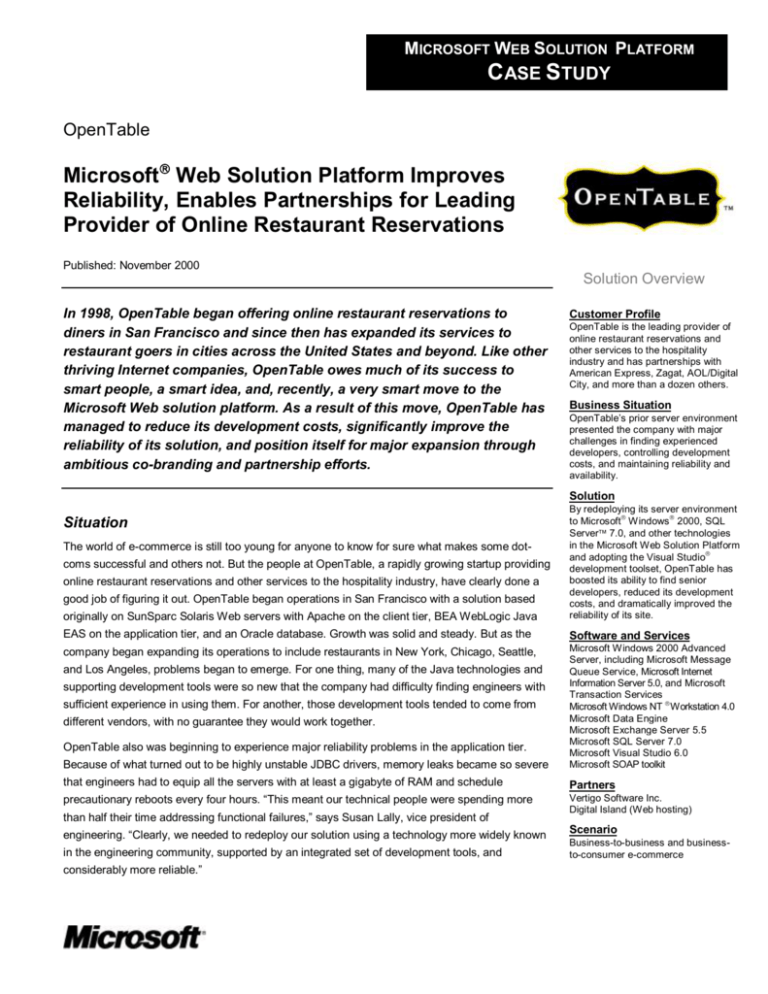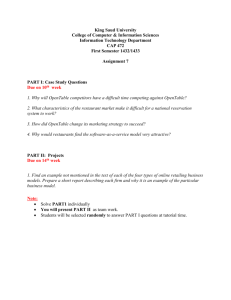
MICROSOFT WEB SOLUTION PLATFORM
CASE STUDY
OpenTable
Microsoft Web Solution Platform Improves
Reliability, Enables Partnerships for Leading
Provider of Online Restaurant Reservations
Published: November 2000
Solution Overview
In 1998, OpenTable began offering online restaurant reservations to
diners in San Francisco and since then has expanded its services to
restaurant goers in cities across the United States and beyond. Like other
thriving Internet companies, OpenTable owes much of its success to
smart people, a smart idea, and, recently, a very smart move to the
Microsoft Web solution platform. As a result of this move, OpenTable has
managed to reduce its development costs, significantly improve the
reliability of its solution, and position itself for major expansion through
ambitious co-branding and partnership efforts.
Customer Profile
OpenTable is the leading provider of
online restaurant reservations and
other services to the hospitality
industry and has partnerships with
American Express, Zagat, AOL/Digital
City, and more than a dozen others.
Business Situation
OpenTable’s prior server environment
presented the company with major
challenges in finding experienced
developers, controlling development
costs, and maintaining reliability and
availability.
Solution
originally on SunSparc Solaris Web servers with Apache on the client tier, BEA WebLogic Java
By redeploying its server environment
to Microsoft Windows 2000, SQL
Server 7.0, and other technologies
in the Microsoft Web Solution Platform
and adopting the Visual Studio
development toolset, OpenTable has
boosted its ability to find senior
developers, reduced its development
costs, and dramatically improved the
reliability of its site.
EAS on the application tier, and an Oracle database. Growth was solid and steady. But as the
Software and Services
company began expanding its operations to include restaurants in New York, Chicago, Seattle,
Because of what turned out to be highly unstable JDBC drivers, memory leaks became so severe
Microsoft Windows 2000 Advanced
Server, including Microsoft Message
Queue Service, Microsoft Internet
Information Server 5.0, and Microsoft
Transaction Services
Microsoft Windows NT Workstation 4.0
Microsoft Data Engine
Microsoft Exchange Server 5.5
Microsoft SQL Server 7.0
Microsoft Visual Studio 6.0
Microsoft SOAP toolkit
that engineers had to equip all the servers with at least a gigabyte of RAM and schedule
Partners
precautionary reboots every four hours. “This meant our technical people were spending more
Vertigo Software Inc.
Digital Island (Web hosting)
Situation
The world of e-commerce is still too young for anyone to know for sure what makes some dotcoms successful and others not. But the people at OpenTable, a rapidly growing startup providing
online restaurant reservations and other services to the hospitality industry, have clearly done a
good job of figuring it out. OpenTable began operations in San Francisco with a solution based
and Los Angeles, problems began to emerge. For one thing, many of the Java technologies and
supporting development tools were so new that the company had difficulty finding engineers with
sufficient experience in using them. For another, those development tools tended to come from
different vendors, with no guarantee they would work together.
OpenTable also was beginning to experience major reliability problems in the application tier.
than half their time addressing functional failures,” says Susan Lally, vice president of
engineering. “Clearly, we needed to redeploy our solution using a technology more widely known
in the engineering community, supported by an integrated set of development tools, and
considerably more reliable.”
Scenario
Business-to-business and businessto-consumer e-commerce
Solution
In late 1999, OpenTable began preparing for the launch of a major co-branded site with
AOL/Digital City that would expand its services nationwide to more than 20 million people. This
meant the company had to implement its redeployment, and quickly, to ensure the scalability that
such a move would require. After considering three other technologies, Lally and her colleagues
decided the Microsoft Web solution platform would be the most capable of meeting the
challenges her team faced. They began work right away. In ten weeks, working first with
Microsoft Solution Provider Vertigo Software and then on their own, Lally’s team redeployed the
OpenTable solution to a virtually 100-percent Microsoft environment.
m)
(Mode
ial-up
56K D
“There simply are more
senior developers
experienced in Microsoft
server products and
Microsoft development tools
than in almost any other
technology. This makes it
infinitely easier for us to find
top-notch engineering
professionals.”
Susan Lally
Vice President of Engineering
OpenTable
OpenTable.com
Member
Internet
Palm VII User
Wir
el
ess
A
cce
ss
Radio tower
WAP Phone User
Proxy Servers/Firewalls
ERB1
www.opentable.com
OpenTable
Private Network
(ATM)
ERB2
DSL Router
Restaurant
Switch
192k SDSL
CLEC
Equip.
ERB1
ERB2
DSLAM
ILEC Central
Office
DSL Router
Restaurant
Figure 1 Architecture of the OpenTable online restaurant-reservation system, including Web-based server
application and PC-based client application distributed to participating restaurants.
Today, that solution consists of a server side, which is the Web-based online restaurantreservation system, and a client side, which is a desktop-based application tied into the online
system and distributed to participating restaurants. The server side is supported primarily by the
Microsoft Windows 2000 Advanced Server operating system, including Microsoft Message
Queue Service and Microsoft Transaction Services; Microsoft Visual Basic and Microsoft C++
COM+ objects (providing the business-logic tier); Microsoft SQL Server
7.0 (providing the data
tier); Internet Information Server 5.0; Microsoft Exchange Server 5.5; and Microsoft Active Server
Pages (providing the pages for users accessing the Web site).
“With the Microsoft
environment we’re free of the
instability problems and
functional failures that
plagued the previous
system. Consequently, site
availability is higher and
engineers can spend less
time fighting fires and more
time enhancing functionality.”
Mark Deaton
Director of Information Technology.
OpenTable
The client side, which runs on touch-screen PC devices based on the Windows NT Workstation
4.0 operating system, stores data in the Microsoft Data Engine, a database technology based on
SQL Server 7.0 and fully compatible with it. For both server- and client-side development and
enhancement, OpenTable relies on Microsoft Visual Studio, including Visual Basic, Visual C++,
Visual SourceSafe, Visual InterDev, and the Microsoft SOAP toolkit.
Benefits
Development Resources Easier to Find, More Productive
Now that OpenTable has been running its solution on the Microsoft Web solution platform,
supporting a system that now includes restaurants in at least 20 U.S. cities as well as London and
Paris, Lally and her colleagues consider their move to the Microsoft technology a major success.
For starters, they’re enjoying far greater access to development resources than they did under
the prior technology. “There simply are more senior developers experienced in Microsoft server
products and Microsoft development tools than in almost any other technology,” she says. “This
makes it infinitely easier for us to find top-notch engineering professionals.”
In addition, once those engineers begin work at OpenTable, they can be far more productive than
they might have been in the prior environment. Lally says there are three reasons for this. “One,
the out-of-the-box integration provided by the Microsoft toolset minimizes the number of
“In the earlier environment
we faced sharp increases in
price as we increased
capacity. In contrast, the
Microsoft Web Solution
Platform supports a
continually scaling model.”
Chuck Templeton
Vice President of Business Strategy
OpenTable
development variables. Two, using a set of technologies that spans both server- and client-side
development means that engineers can more easily share knowledge. Three, integration between
the server and client databases is a given because we’re using SQL Server technology on both
sides,” she says. “As a result, development and maintenance costs are lower and time-to-market
is shorter.”
Ending the Instability, Scaling Easily and Cost-Effectively
OpenTable also has enjoyed increased reliability and scalability with the Microsoft solution. “With
the Microsoft environment we’re free of the instability problems and functional failures that
plagued the previous system,” says Mark Deaton, director of information technology.
“Consequently, site availability is higher and engineers can spend less time fighting fires and
more time enhancing functionality.” Another benefit comes from the close integration of SQL
Server with Microsoft Exchange Server, which has enabled OpenTable to automate the
notification process for SQL Server alerts and thereby simplify site maintenance and quality.
Still other advantages of using the Microsoft Web solution platform are becoming especially
apparent as OpenTable grows its business into an ever-expanding base of cities. For example,
with the business-logic tier now based on COM+ objects instead of the unstable and memoryintensive JDBC drivers of the prior environment, the solution can support four times the number
of concurrent users as before. Scaling up is a lot more cost-effective as well. “In the earlier
environment we faced sharp increases in price as we increased capacity,” explains Chuck
Templeton, founder and vice president of product strategy. “In contrast, the Microsoft Web
solution platform supports a continually scaling model.”
No longer distracted by reliability problems, OpenTable developers are working on a major
enhancement that will provide an easier way for the company’s partners to access the restaurantreservation system. To do this, the developers are using the Microsoft Visual Studio SOAP toolkit
“It’s a given that we’ll be
wanting to grow our solution
pretty steadily in terms of
functionality and capacity. So
it’s comforting to know that
we’re using a platform that
will support that.”
Susan Lally
Vice President of Engineering
OpenTable
to develop an XML-based co-branded interface that will enable a partner to provide OpenTable
reservations to users directly, through its own site. “This enhancement will give partners an added
service they can provide to their customers,” Templeton says. “It also will enable OpenTable to
vastly broaden its visibility to the public.”
Expanding Web Services
As for the tools to support other enhancements, OpenTable executives are considering Windows
2000 Datacenter Server and products in the Microsoft .NET Enterprise Server family such as
SQL Server 2000, for its support of distributed partition views and enhanced scalability, and
Microsoft Exchange Server 2000, for its integration with the Windows 2000 Active Directory and
the cross-company resource-management capabilities offered by that technology.
Although it’s too early to say what additional functionality OpenTable developers will be building
into the solution, it will definitely be tied to the company’s continuing growth. This makes Lally all
the more satisfied with her company’s move to the Microsoft Web solution platform. “It’s a given
that we’ll be wanting to grow our solution pretty steadily in terms of functionality and capacity,”
she says. “So it’s comforting to know that we’re using a platform that will support that.”
The Microsoft Web solution platform enables building and deploying integrated Web solutions
that get to market quicklyfrom high-traffic e-commerce Web sites to corporate intranets to
enterprise supply chain integration. It provides the fastest, easiest way to develop Web
applications that integrate and interoperate with existing applications, suppliers, customers,
and future applications and devices. The Microsoft Web solution platform consists of a set of
complementary products that provide unmatched enhancement and adaptability of Web
applications today and in the future. The core is Windows 2000, an operating system and
application server with built-in Internet services that enables developers to focus on adding
business value to their applications. Building blocks include Visual Studio, SQL Server, Site
Server 3.0, Site Server 3.0 Commerce Edition, SNA Server and the COM+ component and
programming model. All are best-of-breed products and technologies leveraging the skill and
knowledge of more developers worldwide than any others.
For More Information
For more information about Microsoft products or services, call the Microsoft Sales Information Center at
(800) 426-9400. In Canada, call the Microsoft Canada information Centre at (800) 563-9048. Outside the 50
United States and Canada, please contact your local Microsoft subsidiary. To access information via the
World Wide Web, go to http://www.microsoft.com/. For more information on OpenTable products or services
call 1.800.OPENTABLE (1-800-673-6822) or visit its Web site at http://www.opentable.com/
© 2000 Microsoft Corporation. All rights reserved.
This case study is for informational purposes only. MICROSOFT MAKES NO WARRANTIES, EXPRESS OR
IMPLIED, IN THIS SUMMARY. Microsoft, ActiveX, BizTalk, Visual Studio, Windows, and Windows NT are
either registered trademarks or trademarks of Microsoft Corporation in the United States and/or other
countries. The names of actual companies and products mentioned herein may be the trademarks of their
respective owners.







